Tullamore Golf Club is situated in the heart of the Irish Midlands and this year it celebrates one hundred and twenty five years in existence. It was established as a 9-hole course in 1896. To celebrate its one hundred and twenty five years years, Tullamore has been honoured in hosting the 2021 Irish Amature Close Championship in August. Past winners of this event include Shane Lowry, Rory McIlroy, Padraig Harrington, Paul McGinley, and Darren Clarke.
When you arrive at Tullamore Golf Club you are greeted with the sight of mighty oak, sycamore, ash and beech trees, many of which were planted as a relief scheme during Irish Famine of 1847. In 1896, however, the club was located at the racetrack in Ballykilmurray. It moved location in 1906 to the Briscoe lands at Screggan where the club existed, rent free, for 20 years. In 1926 it relocated to its present home at Brookfield, part of the beautiful Charleville Estate, but outside of the demesne.
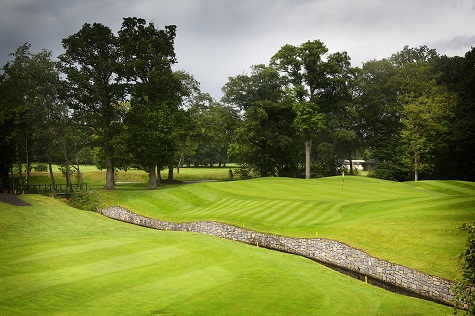
The signature 16th hole with a beautiful natural stone wall along the drain. Photo Alan Mahon
When the club acquired the lands at Brookfield, Captain Lionel Hewson, an experienced course designer, laid out 18 holes and work commenced on his plan in the summer of 1925. In 1938 the club invited James Braid, a five time Open winner, to visit Tullamore and inspect the course and recommend what changes should be made to improve the overall standard of Brookfield. This was to be of significant benefit, as Braid suggested four complete new holes, among other changes, which also included a bunkering plan. The bulk of the work on the course was carried out over a three year period. The final part of Braid’s plan, a new 18th green, was not completed until 1945.
In 1968, after lengthy negotiations, a new 50 year lease was agreed. The new rent was £500 a year. The main advantage to the club was that this removed the grazing sheep from the course.
The course was to remain largely unchanged until 1995 when, under the direction of Paddy Merrigan, 7 new sand based greens (sown then with a slender creeping red fescue and brown top bent mix), 11 sand based tees and three lakes were developed. Some unused ground to the right of the 12th hole was brought into play and over 1000 new trees were planted. Extensive drainage was also carried out on holes 5, 6, 7, and 8. The redesigned course was opened in September 1996, the club’s centenary year.
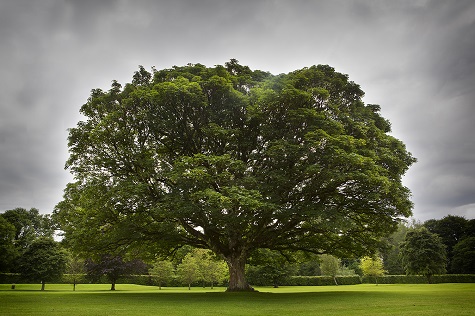
This giant sycamore is one of many mature trees growing around the golf course. Photo Alan Mahon
Back in the early 2000’s, when Ireland was in the middle of the construction boom, many golf clubs decided to turn their clubhouses into modern facilities, each development costing millions of euro. Tullamore had its own plans to create a two-storey clubhouse and was tempted to join the trend of other clubs. They decided against this, putting the money instead into improving the course over several years. On hindsight this turned out to be a wise decision as many clubs paid, and still are paying the price for lavish developments.
The first of these course improvement plans was the redesign, in 2003, of the bunkers. They had been encroaching towards the greens and many of them had different types of sand. In 2006 a new maintenance facility was built. Patrick Merrigan was brought back again in 2007 when the remaining seven soil tees were converted to sand, sown with 70% American Ryegrass (using Roadrunner and Topgun), 20% slender creeping red fescue (Barcrown) and 10% Highland bent. 2008 saw the redesign of the 16th hole, which included new stone walls at the river in front of the green. The fairway was graded back 50 metres sos as to make the wall more visible. New bridges were built at the 15th and 18th holes, with improvements to the river banks at these holes and also to the 10th. In 2009 more drainage and sand slits were added to to holes 10, 12, 15, and 17. All this was money well spent at a fraction of the cost of a new state of the art clubhouse. It is hoped that the remaining 12 greens will be eventually be converted to sand based greens.
In conjunction with the club’s course architect, Ken Kearney, Mark and the greens committee have identifed the soil based greens in most need of upgrading to sand based. Plans have been drawn up and it is hoped to put these to the members later this year for their approval to start some of the upgrades next year.
The course superintendent at Tullamore is Mark Murphy. Mark started his greenkeeping career on a work experience programme in Mullingar Golf Club in 1991, while studying horticulture in Multyfarnham College. He loved working on the course in Mullingar and decided that greenkeeping was the career for him. After finishing his studies in Multyfarnham, Mark got work on the newly built golf course at Luttrellstown Castle in Dublin, working during the grow-in period. He was promoted to Assistant Course Superintendent in 1997 and in 1998 he applied for, and succeeded in filling the vacant position of Course Superintendent at Tullamore Golf Club where he has remained ever since. In his 23 years at the helm at Tullamore,

Course superintendent Mark Murphy. Photo Alan Mahon
Mark and his staff have transformed the course to what it is today. There are four full time staff working with Mark. An extra greenkeeping staff member is hired during the growing season.
Trees
If you take the trees away from Tullamore golf club then you also take away its soul. It boasts some wonderful specimens. In the nearby Charleville Estate stands the famous King Oak. With a girth of 8 metres below its branches it is one of the oldest, largest and best preserved oaks in Ireland. No one knows who planted the tree or whether it sowed itself, but it seems to be a descendent of the great forests of common oak (Quercus Robur) that once straddled the plains od central Ireland. Estimates of the age of this tree begin at 400 years but it could be double that. In 2007 Rev. David Hutton-Bury, who represents the owners of the Charleville Demesne, donated two oak trees to the club which are grafts from the King Oak. One of the trees was planted at the back of the 18th green and the other on the left of the 15th and 18th fairways and are still thriving today.
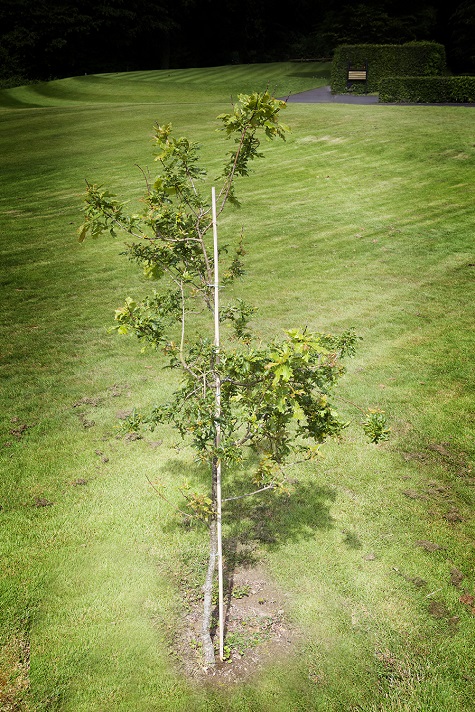
A sapling from the original King Oak of the Charleville Estate. Photo Alan Mahon
However there is a price to be paid for having so many wonderful trees growing around the course. Leaves cause a huge headache for Mark and his staff. From the end of October until Christmas they are mainly preoccupied with blowing and collecting leaves and branches.
Course maintenance
An agressive seeding programme was introduced 3 years ago which includes overseeding the greens with 75% browntop and 25% creeping bent in May and August. Height of cut of the greens has been increased to 3.5mm in summer and 5mm in winter to encourage the establishment of these bent grasses.
Pencil tinning takes place every 5 - 6 weeks and greens are verti drained in late October. They receive at least 150 tonnes of sand per annum. The sand greens get between 80 & 90 kgs of nitrogen and the soil greens around 70 - 75 kgs per annum. A plant growth regulator (PGR) is used at regular intervals during the growing season. Soil moisture is measured twice weekly during the summer months in conjuction with wetting agents to determine irrigation use.
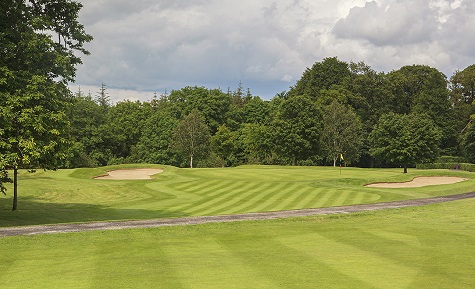
The 18th green. Photo Alan Mahon
To minimise the use of fungicides, a programme of dew suppressant and penetrant wetting agents are used during the winter months.
Being a midland course, the land at Tullamore is very heavy. Drains and sand slits were installed over a number of years. Sanding of the fairways is done each September. The fairways are mown at 13mm during the summer, increasing to 19mm in winter. They are fed every 4-5 weeks in summer using a high nitrogen soluble feed (46:0:0) at 1-2 bags (25kg) with three quarters of a bag of iron per hectare, along with a PGR being added to the tank. In winter some sulphate of ammonia and sulphate of iron is applied. The fairways are verti drained each spring and autumn using 25mm tines.
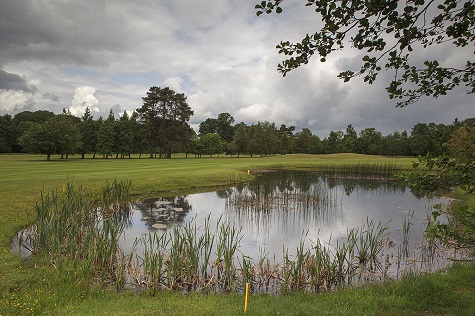
The water feature on the 5th hole. Photo Alan Mahon
Tees are sanded twice a year and fed with a high nitrogen feed such as 22:5:6 every 8 weeks. They also get a light liquid feed with iron and PGR in between feeds The height of cut of the tees is 13mm in summer and 15mm in winter.
In 2018 remedial work was carried out on some of the bunkers that had fallen into disrepair. They were built using capillary concrete and edged with eco bunker edge.
Wildlife
Wildlife is abundant in Tullamore. Deer can be seen early in the mornings, a pleasant sight for the staff and early golfer. The deer retreat back into the woods during the day. There are over 100 in the herd.
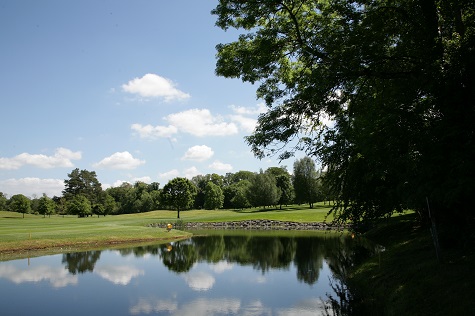
The lake on the 8th hole. Photo courtesy Mark Murphy
Suprisingly, red squirrel populations are on the increase, despite them sharing the same territory as the dreaded grey squirrel. One theory for the rise in red squirrel population is that pine martins have taken up residence and, as the grey squirrel spends most of its time on the ground, they can fall victim to the lurking pine martin. Other animals habiting the course include hares, badgers and rabbits. Carp and rudd were introduced to the lakes and are thriving. Recently a woodpecker has been heard on the course.
Some areas of the rough have been allowed to grow unmown, encouraging wild flora to colonise.
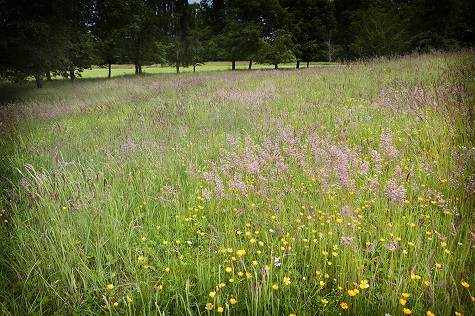
Some areas of rough are left uncut to encourage wild flora to colonise. Photo Alan Mahon
Some interesting facts
- In the early years, the landlord had the right to graze sheep on the course. As fertiliser was not always easily available, the sheep droppings were gathered up, mixed with water, and the resulting solution spread on the greens.
- The first tractor for the club was bought in 1937 for £210 but with the difficulties of kerosene supplies during World War II, the tractor had to be sold in 1943 when horses were again used with the course machinery.
- While playing the 7th hole, a member’s ball went crashing through the trees, killing a heron in the process.
- Iron stakes were installed around the course during Worl War II to prevent German aircraft using the golf course as a landing strip.
- Tullamore golf club has hosted many championships including: All Ireland cups and shields; Irish inter provincial; Boys inter provincial; Irish boys championships; Irish girls championships; Irish senior ladies close championships; All Ireland Ladies fourball finals; and numerous provincial and district finals
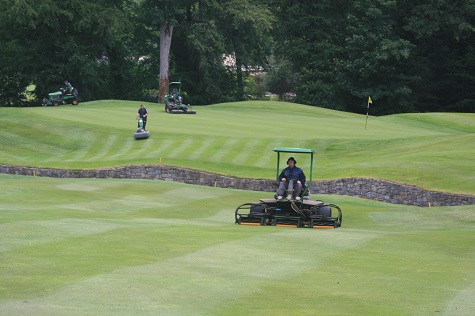
Staff busy with their machines around the 16th green as they get ready for the long awaited opening up of the course on April 26th. Photo courtesy Mark Murphy
Tullamore is a challenging parkland course. The club is looking forward to opening its gates, once again, to golfers, albeit on a restrictive level. The sound of balls crashing through trees, shouts of FORE!!! and cheers of long putts being holed out will soon be heard throughout the course.
A sign that things are getting back to normal.
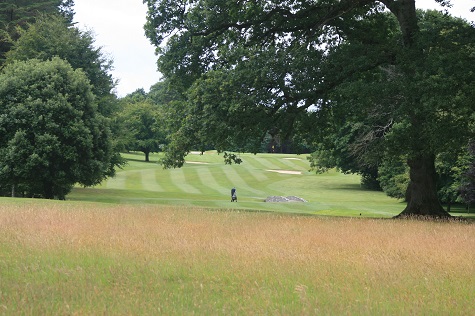
The 15th hole. Photo courtesy Mark Murphy